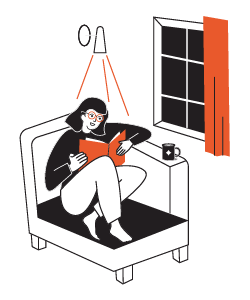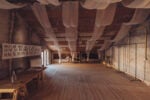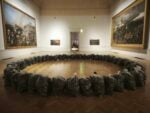Massimo Bartolini
.jpg)
L’artista toscano ha elaborato un percorso di opere che trovano in Marino Marini e Leon Battista Alberti il loro punto di incontro e la loro sorgente di riflessione. La mostra, come afferma Bartolini stesso, è fatta in loro presenza, generando nuovi lavori e portando al museo testimonianze di un percorso e di una ricerca sulla scultura seguita nel tempo.
Comunicato stampa
Il Museo Marino Marini inaugura il programma espositivo del 2015, sabato 10 gennaio, con la personale di Massimo Bartolini curata da Alberto Salvadori (aperta fino al 10 marzo). L’artista toscano ha elaborato un percorso di opere che trovano in Marino Marini e Leon Battista Alberti il loro punto di incontro e la loro sorgente di riflessione. La mostra, come afferma Bartolini stesso, è fatta in loro presenza, generando nuovi lavori e portando al museo testimonianze di un percorso e di una ricerca sulla scultura seguita nel tempo.
L’esposizione si apre all’interno della Cappella Rucellai con Revolutionary monk, riproduzione di un monaco birmano nella posizione del Bodhisattva, cioè colui che sta a cavallo tra religione e laicità, intesa questa come condizione di presenza attiva nella dimensione sociale, assimilabile all'attività dell’Alberti il quale è stato uno dei più importanti intellettuali del Rinascimento che attualizzò il linguaggio dell’antichità, ovvero rese contemporanea la classicità.Alberti ha realizzato opere che testimoniano una nuova idea di rapporto tra arte e società, in una ieratica manifestazione di equilibrio tra pensiero antico e rinascimentale. Il monaco, con la sua rotazione, interrompe, senza però turbarlo, l’equilibrio tra queste due parti, infondendo nuova energia all’interno di un sistema chiuso come quello della cappella dell’Alberti.
Altro intervento, questo di accostamento, è Airplane che gioca sull’identità del linguaggio formale e della materia. L’opera è un basamento di marmo statuario, la cui faccia superiore ha in se un bassorilievo geometrico che riproduce un aeroplano di carta dispiegato, una lavorazione che evidenzia la preziosità della materia, in dialogo con le tarsie del sepolcro.
Sempre nella Cappella Rucellai una persona del museo, indosserà la sera della vernice, My fifth hommage, due preziosi orecchini in oro facenti parte della serie di opere “Omaggi”. Gli orecchini, fusioni in oro di tappi di cera usati dall’artista stesso, rimandano al silenzio costruito dalla cappella e all’astrazione matematica che questo spazio definisce.
Al piano inferiore del Museo si trova un lavoro che propone un altro modo di fare una scultura, con l'aiuto di due grandi artisti quali Marini e Constable. Utilizzando le nuove tecnologie usate in architettura, si è fatta una scansione 3d della statua di Marini Il Giocoliere, titolo anche dell’opera di Bartolini, della quale si sono trattenute stampandole su carta, le “nuvole” di coordinate sotto forma di 6 numeri per ogni punto rilevato, per un totale di 77 m2 di numeri corpo 4. Il gruppo di coordinate numeriche, chiamate in gergo “nuvole di numeri”, sono state sovrapposte alle opere "Studi di nuvole di Constable". Nuvole di Numeri su studi di Nuvole. La stampa di questa sovrapposizione si rende visibile in 11 fogli di 75x1000 cm che verranno installati, come le affissioni pubbliche, sul fronte e sul retro di un grande muro costruito al centro della cripta del Museo. Ancora una volta l‘artista vuole mettere a confronto la complessità che si nasconde dietro la facile riproducibilità con l'immediatezza irriproducibile del gesto, interrompendo a metà il processo di replica (la scansione non diventerà mai una replica fisica della statua). “La riproducibilità al suo inizio non era che paura della perdita, perdita che presiede a ciò che per la manualità è uno dei più grandi valori: la mutevolezza”.
Nascosta ed introdotta dal muro del Giocoliere, appare un’altra riflessione sulla scultura, stavolta sotto forma di azione: due persone si appropriano eleggono, alternandosi, un testo fondamentale per la storia dell’arte del ‘900, Scultura lingua morta di Arturo Martini, grande artista italiano al quale Marino Marini deve molto, e al quale succedette ben due volte alla cattedra di scultura a Monza. Le due persone leggendo lo stesso libro, una ad alta voce l’altra in silenzio, ci mettono di fronte al doppio registro dell’invettiva da una parte e dell’analisi interiore dall’altra, tema centrale del testo.
Questa azione si svolge sullo sfondo ad un lavoro audio diffuso nella cripta che ha per titolo Petites esquisses d'arbres, una parafrasi di un titolo di una serie di sonate per pianoforte chiamate Petites Esquisses d' Oiseux di Olivier Messian. L’artista ha registrato il rumore del vento tra gli alberi del suo studio e della casa - alberi che sono oggetto dal 1995 di numerosi disegni - al vento di ogni albero è stata poi assegnata una nota e sovrapposta alle note e agli intervalli dei tre brani della sonata per piano di Messiaen, la quale talvolta echeggia in lontananza: “Mi piaceva fare un disegno in un altro modo, pensare che degli alberi facessero il verso agli uccelli tramite il ponte di Messiaen e che il vento sia armonia”.
La mostra è prodotta dal Museo Marino Marini di Firenze con il supporto di Regione Toscana, OAC Ente Cassa di Risparmio di Firenze. Si ringrazia per la preziosa collaborazione la Galleria massime De Carlo MilanoLondra.
Massimo Bartolini è nato a Cecina nel 1962, vive e lavora a Cecina. È uno degli artisti italiani più riconosciuti della sua generazione. Il suo lavoro è stato presentato in varie mostre personali tra le quali ricordiamo: “It’s mine! Paesaggio e appropriazione”, MART, Rovereto (2014); “Studio Matters + 1”, Fruitmarket Gallery, Edinburgo (2013); “Hum – Massimo Bartolini”, AuditoriumArte, Roma(2012); “Il cuore in mano”, Center of Contemporary Art Znaki Czasu, Touron, Polonia (2011); “Basements”, Massimo De Carlo, Milano (2011);”Massimo Bartolini. Dews”, Institute of Contemporary Art, Sofia, BG (2010); “Dialoghi Con La Città”, a cura di Laura Cherubini, MAXXI, Roma (2008); “Massimo Bartolini: Concert room with voices”, D’Amelio Terras, New York (2008); “Triple loop”, Ikon Gallery, Birmingham, UK (2007); “Massimo Bartolini”, Museu Serralves, Oporto (2007).
Ha inoltre partecipato a numerose mostre collettive e rassegne internazionali tra come:“La disparition des lucioles”, Prison Sainte-Anne, Avignone, F (2014); “Vice versa” – Padiglione Italiano alla 55ma Biennale di Venezia (2013); Documenta 13, a cura di Carolyn Christov-Bakargiev, Museum Fridericianum, Kassel, D (2012); “T.R.A.C.K.S., SMAK”, Ghent, B (2012); “One To One”, Berlin Biennale - KW Institute for Contemporary Art, Berlin, D (2012);“Yokohama 2011: International Triennale of Contemporary Art”, Sedi varie, Yokohama, JP (2011); “Fare Mondi/Making Worlds”, a cura di Daniel Birnbaum, 53a Biennale di Venezia (2009); “Una Stanza tutta per sé”, Castello di Rivoli (2008); “Scenes du Sud: Espagne, Italie, Portugal”, Carrè d’Art – Musée d’Art Contemporain de Nimes, Nimes, F (2007); Public Art Project”, Art 37 Basel, Basel, CH (2006); “Ecstasy: In and About Altered States”, The Geffen Contemporary, Los Angeles, U.S.A. (2005).
the museo marino marini is inaugurating its 2015 program on saturday, january 10, with a solo exhibition of massimo bartolini curated by alberto salvadori. the tuscan artist has elaborated a series of works whose meeting point and source of reflection can be found in marino marini and leon battista alberti. the exhibition, as bartolini himself declares, takes place in their presence, generating new works and bringing to the museum testimony of the artist’s development and his research on sculpture over the years.
the exhibition opens in the rucellai chapel with revolutionary monk, the image of a burmese monk in the bodhisattva position, that is, embracing both the religious and the secular. the latter is seen as a condition of active presence in the social dimension, comparable to the activity of alberti, one of the greatest renaissance intellectuals, who modernized the style of antiquity, rendering the classical contemporary. alberti created works expressing a new concept of the relationship between art and society, in a hieratic manifestation of equilibrium between the thought of antiquity and that of the renaissance. the monk, with his whirling motion, interrupts but does not disturb the balance between these two elements, instilling new energy into a closed system such as that of alberti’s chapel.
another work, this time a connection, is airplane, which plays on the identity of formal language and matter. the work consists of a base of statuary marble whose upper face bears a geometric bas-relief representing an unfolded paper airplane, an image that emphasizes the precious nature of the material, in dialogue with the inlay work decorating the tomb.
on the evening of the show, again in the rucellai chapel, a representative of the museum will wear my fifth homage, consisting of two precious gold earrings from the “omaggi” [homage] series. the earrings, gold castings of wax earplugs used by the artist himself, refer to the silence produced by the chapel and to the mathematical abstraction that this space defines.
view the gallery
on the lower floor of the museum is a work proposing another way of making sculpture, with the assistance of two great artists such as marini and constable. utilizing the new technologies applied in architecture, a 3d scan of marini’s statue il giocoliere [the juggler] has been made. this is also the title of bartolini’s work, in which the “clouds” of coordinates have been fixed by printing them on paper in the form of 6 numbers for each point acquried, for a total of 77 sq.m. of 4-point numbers. the group of numerical coordinates, called in slang “numbers clouds”, has been superimposed on the works "studies of clouds by constable". numbers clouds over studies of clouds. the print-out of this superimposition appears on 11 sheets, 75x1000 cm, which will be installed like posters on the front and back of a great wall erected at the centre of the crypt in the museum. once again the artist aims to compare the complexity that lies behind easy reproducibility with the unreproducible immediacy of the gesture, by interrupting the process of replication midway (the scan will never become a physical replica of the statue). “reproducibility was at first only the fear of loss, a loss that presides over what is for manual skill one of its greatest values: changeability”.
both concealed and introduced by the wall of the juggler is another reflection on sculpture, this time in the form of action: two people alternatively appropriate and read a text that is fundamental for the history of 20th-century art, scultura lingua morta [sculpture, a dead language] by arturo martini, the great italian artist to whom marino marini is much indebted, and whom he succeeded to the chair of sculpture at monza. the two people who read the same book, one aloud, the other in silence, confront us with the dual register of invective on the one hand and interior analysis on the other, the central theme of the text.
the action takes place against the background of an audio work transmitted in the crypt, called petites esquisses d' arbres, a paraphrase of the title of a series of sonatas for piano called petites esquisses d' oiseux de olivier messian. the artist has recorded the sound of the wind in the trees in his studio and his home - trees that have appeared in numerous drawings since 1995. to the wind of each tree, a note has then been assigned, superimposed on the notes and intervals of the three passages of messiaen’s sonata for piano, which occasionally echoes in the distance: “i wanted to make a drawing in another way, to think that the trees are echoing the song of the birds through the bridge of messiaen, and that the wind is harmony”.
the exhibition has been organized by the museo marino marini di firenze with the support of the regione toscana, oac ente cassa di risparmio di firenze. we would like to thank the galleria massimo de carlo, milanlondon for its indispensable collaboration.
ph dario lasagni



